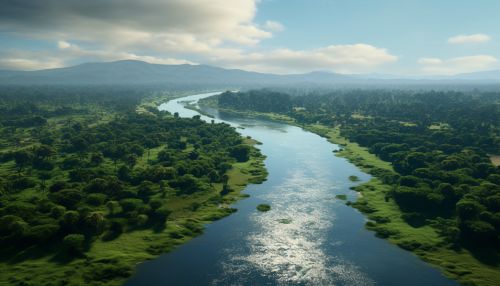Nile River
Geography
The Nile River is a major north-flowing river in northeastern Africa, and is the longest river in Africa and the disputed longest river in the world, as the Brazilian government says that the Amazon River is longer than the Nile. The Nile, which is about 6,650 km (4,130 mi) long, is an "international" river as its drainage basin covers eleven countries, namely, Tanzania, Uganda, Rwanda, Burundi, the Democratic Republic of the Congo, Kenya, Ethiopia, Eritrea, South Sudan, Republic of Sudan and Egypt. In particular, the Nile is the primary water source of Egypt and Sudan.


Course
The Nile has two major tributaries – the White Nile and the Blue Nile. The White Nile is considered to be the headwaters and primary stream of the Nile itself. The Blue Nile, however, is the source of most of the water and silt. The White Nile is longer and rises in the Great Lakes region of central Africa, with the most distant source still undetermined but located in either Rwanda or Burundi. It flows north through Tanzania, Lake Victoria, Uganda and South Sudan. The Blue Nile begins at Lake Tana in Ethiopia and flows into Sudan from the southeast. The two rivers meet just north of the Sudanese capital of Khartoum.
Hydrology
The northern section of the river flows north almost entirely through the Sudanese desert to Egypt, then ends in a large delta and flows into the Mediterranean Sea. Egyptian civilization and Sudanese kingdoms have depended on the river since ancient times. Most of the population and cities of Egypt lie along those parts of the Nile valley north of Aswan, and nearly all the cultural and historical sites of Ancient Egypt are found along river banks.
Ecosystem
The Nile has been the lifeline of civilization in Egypt since the Stone Age, with most of the population and all of the cities of Egypt resting along those parts of the Nile valley lying north of Aswan. However, the Nile is also an important ecological feature, supporting many types of fish and a rich variety of birds. The river is also home to several species of turtles and the Nile crocodile. Despite the river's importance to Egypt, overfishing and pollution have become major problems in recent years, threatening the future health of the Nile.
History
The Nile has had a major influence on the interstate politics of the region through the supply of water, the provision of a transportation corridor, and the fertility of the soil. The river's flow is disturbed at several points by the Cataracts of the Nile, which are sections of faster-flowing water with many small islands, shallow water, and rocks, which form an obstacle to navigation by boats. The Sudd wetlands in Sudan also forms a formidable navigation obstacle and impede water flow, to the extent that Sudan had once attempted to canalize (the Jonglei Canal) to bypass the swamps.
Economic Importance
The Nile River has been used for transportation of goods and people for thousands of years. Today, it continues to serve as a source of irrigation, as well as an important transportation and trade route. It also provides a significant amount of the power generated in the region, especially through the Aswan Dam.
Cultural Significance
The Nile has a profound cultural significance. In ancient times, the Egyptians believed that the Nile River was the source of all life. The river was personified by several Egyptian gods, and each year the Hapi festival was held to celebrate the annual flooding of the Nile.
